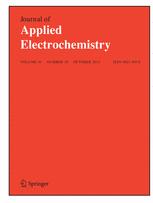Summary: Pristine graphene platelets and graphene oxide were used as electrode modifiers, aiming the investigation of their electrochemical efficacy towards β-nicotinamide adenine dinucleotide (NADH). The electrochemical detection of NADH is one of the most studied areas of bioelectroanalysis because of the ubiquity of NAD(P)H-based enzymatic reactions in nature. Commercially available graphene and laboratory prepared graphene oxide were used to modify glassy carbon electrodes and the behaviour of such modified electrodes against potassium ferricyanide (III) and NADH was reported. Relying on the graphene-modified transducer, l-lactic dehydrogenase (l-LDH) was successfully immobilised in a 1 % Nafion® membrane. The developed biosensor, working at +250 mV versus Ag/AgCl reference electrode, was used to assess l-lactic acid in four different types of yogurts, revealing an l-lactic acid concentration ranging between 0.3 and 0.6 %.p>
l-Lactic acid biosensor based on multi-layered graphene
